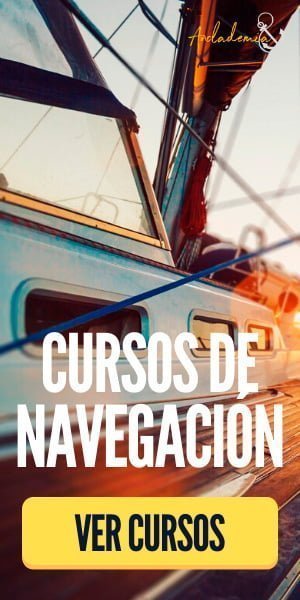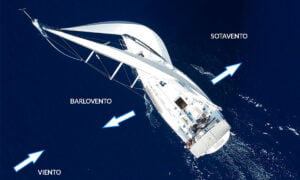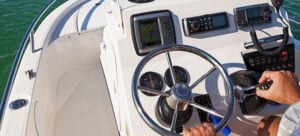Prevention to avoid a man overboard situation: Safety harness, lighting
Among the most effective to prevent falls is safety harness, without forgetting that the cover must have a anti-slip and that the lampstands be tall and strong in addition to using suitable shoes. On the other hand, unnecessary exits to the deck must be avoided and when it has to be done due to force majeure, do so with caution, avoiding sudden movements.
The lightning of the deck, especially in the bow on sailing boats, must be sufficient but taking into account that should not affect navigation lights. However, at the moment of the fall it is important to turn on a light. that illuminates towards the sea to be able to see it.
Man overboard, signal, mark and launch
At the moment of the fall, if you are seen by any crew member, you must shout the phrase “man overboard for…,” (port or starboard), so that at that moment who is piloting the boat stop machines and put all the rudder on the landing band With this maneuver the castaway will be free of propeller blades. Next, the lifebuoy, or any other floating element that we have on hand in order to mark the drop point At the same time, it will help you hold on to it and even floating objects will be launched in short periods of time which could help you. If possible, write down the time and position and keep track of it.
There are several types of individual beacons (fixed on life jackets or belts) which, if activated (manually or automatically), emit a signal, which is collected by an onboard receiver that allows easy location, with a range of 1 to 3 miles for boats. and about 10 miles for rescue flights.
Anderson and Boutakow maneuver
Anderson Maneuver
Once the rudder has been placed on the landing band and the machine has stopped if necessary, the engine will be activated. with the rudder on the landing side until the bow falls 270o at which time the shipwrecked person will appear over the bow, then leaving himself on the leeward side to give him shelter.
Boutakow maneuver
It consists of putting all the rudder on the side that has fallen shipwrecked and when it has fallen 70o from the initial course, the rudder is changed to the opposite side, describing a circle and when it is in the opposite direction to the one it was on before the man fell into the water, he should appear over the bow.
Square spiral and sector exploration
In this search, whether it is a member of our crew or another, the first thing is tick (with a buoy or on the plotter) a spot initial or datum, which will be either the fall reference point we have or the data they provide us.
to) Square Spiral Scan: the use of radar or plotter can be very convenient since leaving any detectable object (eg a radar reflector) in the datum, the spiral sweep can be carried out around the datum, each turn separating the width of the sweep street.
b) Exploration by sectors This technique tries to explore radially from the datum with 120o turns to starboard being the route for small boats of one mile a little more or less. Once you have traveled through the 3 sectors changes course 30° to starboard from the datum and proceed in the same way for the exploration of the next sector.
Are you interested in: List of the theoretical syllabus for the PER degree
Use of GPS in case of man overboard
If we have this device immediately after the fall, press the MOB key (Man Over Board) twice, in this way that place of fall becomes a mark or way point so if below we press the ENT key, The GPS itself will indicate the direction we must take to find the exact point of fall and consequently the shipwreck must be in its vicinity.
Precautions
When we have located the shipwrecked man we will govern in a way that we will approach from our lee or what is the same as windward of the shipwreck and thus be able to give it protection (protection) by throwing a lifebuoy with a tail to bring it closer to the side and providing it with a ladder if necessary. In the event that he is unconscious, a crew member attached to the boat with a rope will approach and approach the side. Once on board you will be placed in a dry and sheltered place, provide dry clothes and hot drink but no coffee, tea or alcoholic beverages.
Resuscitation of a castaway: Mouth-to-mouth resuscitation and cardiac massage
As a first action, we must act quickly, requesting the help of all available people, giving encouragement to the victim. to) Mouth-to-mouth:
- It will be verified that both in the nose and in the mouth does not have any foreign body (food remains, algae, dental prosthesis).
- You will they will loosen all the clothes (shirt, sweaters, belt, wetsuits)
- For a few moments it will be placed face down to expel the swallowed water.
- You will be given the hand on the back of the neck to lift the neck and tilt the head back everything that is possible, chin pulling up until the head is tilted back.
- Placing a gauze or handkerchief over your mouth air was blown in, covering his nose.
- These maneuvers should not be suspended in intervals of about 5 seconds, until the asphyxiated person begins to breathe.
b) Heart massage: When we evaluate the condition of an injured person, it is essential to know if they have a pulse. The quickest way is to palpate the carotid artery, which is in a channel formed between the lateral muscles of the neck. If you do not find a pulse, you must quickly proceed to perform cardiac massage. Position of the hands in cardiac massage:
- Locate the lower edge of the rib cage and locate the place where the ribs join the sternum.
- Place the palm of your hand two fingers' distance above this point, with your fingers facing to the side.
- Place your other hand on the one that is already resting on the chest of the injured person, so that both are parallel.
- Raise the fingers of both hands, so that the pressure is applied accurately. The pressure must be done decisively, pressing about 4 cm deep, to achieve cardiac contraction, it must be done vertically, downwards. You must lean over the patient, without bending your elbows. The cardiac massage is repeated 60 to 90 times per minute in adults and 80 to 100 in children.
c) cardiopulmonary resuscitation: In case of cardiac and respiratory arrest it is necessary to combine the methods described above, as follows:
- Place the patient horizontally, in a position suitable for mouth-to-mouth resuscitation.
- If you do not have help, you must apply 2 mouth-to-mouth breaths for every 15 cardiac massages.
- If you have help, one should practice mouth-to-mouth breathing and the other cardiac massage, combining in this way: 1 mouth-to-mouth respiration 5 cardiac massages.
Hypothermia: Concept and measures to take
It is generally due to the action of cold, either locally varying from a simple chill to complete frostbite (the most affected parts being the ends of the fingers, tip of the nose and ears) or completely causing the so-called symptoms. of hypothermia. In relation to navigation, the most frequent are falls into the sea, where in addition to the cooling of the body, the decrease in ambient temperature and other factors such as wind, humidity, exposure time, immobility, fatigue, etc.
In these types of accidents, body temperature generally drops to less than 34oC, the pulse and breathing slow, the ends of the limbs become more insensitive and the skin becomes pale, with the appearance of very painful blisters. Below 35º body heat, fatigue, lack of coordination, and lightheadedness begin to occur. and below the 31st loses consciousness and the pulse becomes weak.
The general treatment in these is to remove the affected person to a dry and temperate place, removing wet clothes. Try slowly increase body temperature through baths with warm water, administering hot sugary drinks, and do not offer alcohol. Apply solution antiseptic in blisters if there are any and carry out medical radio consultation.





